NTRC takes pride in its research and
development of the optical communication technology and aims
to explore and design new methodologies for implementing
next-generation optical networks. This section provides the
highlights of some of our recent research activities.
Fibre grating
based devices and fabrication systems
A fibre grating is a region of fibre whose
refractive index has been permanently modified by exposing to
light. Such exposure, if carried out with an interferometer or
phase mask, allows a periodically varying refractive index
grating or pattern to be “written” into the core of optical
fibre. These “in-fibre” components are spectrally selective,
which allow only specific wavelengths to be reflected or
rejected, and are thus suitable for performing many tasks such
as filtering and reflecting, in a highly efficient, low loss
manner.
In NTRC, one of our research focus is on
fabrication and applications of fibre gratings, including
fibre Bragg gratings (FBG) and long-period gratings (LPG). An
in-house designed Fibre Grating Fabrication System with
sophisticated software for fabrication process control has
been setup, allowing various types of fibre gratings to be
fabricated including complex grating structures such as Moiré,
sampled, chirped and phase shift gratings. For the first time,
we have also demonstrated the possibility of directly writing
gratings on an optical fibre coated with standard
off-the-shelf coating, with the resulting reflectivity and
index change found to be equivalent to that of a fibre grating
fabricated with bare fibre. A US patent on this grating
writing technique has since been filed.
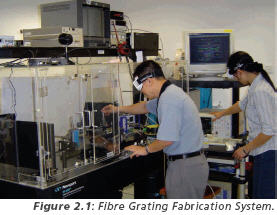 In
addition to grating fabrication, we have been studying the
applications of fibre grating, particularly for communication
applications. A noteworthy example is the recent work by Dr
Dong Xinyong and his team on novel fibre grating-based optical
fibre filters, in which they developed a bandwidth-tunable FBG
filter with record tuning range (see Figure 2.2) and
several LPG-based WDM filter designs (see Figure 2.3)
that has potential applications in the present WDM
communication systems. Another area we are pursing is the
optimization of the gain profile for optical amplifiers by
means of fibre gratings. Other investigations on grating-based
optical devices such as filters, fibre lasers, add/drop
multiplexers, and cross-connects for optical communication, as
well as sensor element for optical sensing, are also being
carried out.
In
addition to grating fabrication, we have been studying the
applications of fibre grating, particularly for communication
applications. A noteworthy example is the recent work by Dr
Dong Xinyong and his team on novel fibre grating-based optical
fibre filters, in which they developed a bandwidth-tunable FBG
filter with record tuning range (see Figure 2.2) and
several LPG-based WDM filter designs (see Figure 2.3)
that has potential applications in the present WDM
communication systems. Another area we are pursing is the
optimization of the gain profile for optical amplifiers by
means of fibre gratings. Other investigations on grating-based
optical devices such as filters, fibre lasers, add/drop
multiplexers, and cross-connects for optical communication, as
well as sensor element for optical sensing, are also being
carried out.
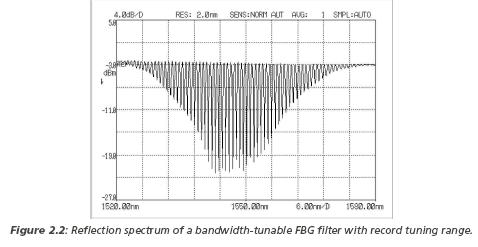
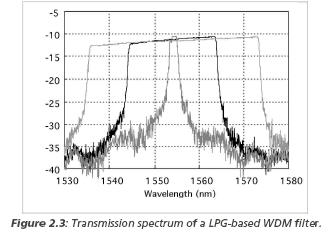
Generalized Multiprotocol Label Switching
Current data network infrastructure
consists of multiple switching technologies: the IP packet
switch, ATM/FR cell switch, SDH TDM switch and the emerging
wavelength switch and fibre switch. The heterogeneity of the
diverse network infrastructure makes the control and
management an insurmountable task. To simplify the task of
performing network operations and provide efficient network
resource utilization, Generalized Multiprotocol Label
Switching (GMPLS) has been proposed as the unified control
plane for a variety of networks capable of switching in the
packet, time, wavelength, and space domains. GMPLS is an
evolution of MPLS-TE, with essential enhancements to its
routing and signaling protocols and the addition of a new Link
Management Protocol (LMP).
In this project, we have proposed the novel
model of GMPLS enabled multilayer router, shown in the Figure
2.4, and successfully developed the GMPLS prototype system
based on PC/Linux platform. We then built a network testbed
composed of the prototype GMPLS router to demonstrate
essential aspects of GMPLS network operation, such as
constraint based routing, path provisioning, integrated
multilayer routing, network management etc. The implementation
experience allows us to explore the insight of the GMPLS
technology and related issues for the construction of next
generation Internet infrastructure. New GMPLS related research
issues with practical significance have been identified. These
include the integrated multilayer network routing and GMPLS
control plane scalability.
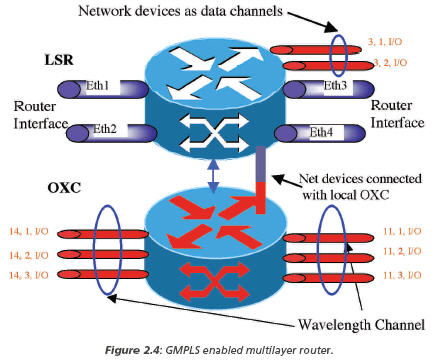
Channel Performance Monitoring for
Terabit WDM Networks
Optical networks have an inherent property
of transparency. This property makes it possible to support
various data rates and coding formats simultaneously on the
same network. In addition to this great flexibility,
transparency also protects investments against future
developments. Once deployed, an all-optical network will
support a variety of future protocols and data rates without
making major changes on the network as data is delivered from
its source to its destination completely in optical form
without undergoing any optical-to-electrical conversion. In
such a transparent optical network, one of the most
challenging tasks is to monitor, control and manage optical
channels, since the signal quality may be affected by both
linear and non-linear optical effects such as dispersion,
crosstalk, amplifier noise, self-phase and cross-phase
modulations. The most direct way to evaluate a digital
transmission system is to measure its bit error rate (BER).
The project aims are:
(1) to propose new methods for monitoring
BER of optical channels and identifying various sources of
signal degradations;
(2) to develop advanced analytical models
and software tools for studying various signal degradation
mechanisms;
(3) to build and test an optical channel
monitoring system.
So far we have developed a new BER
monitoring technique based on signal’s amplitude histogram and
curve fitting. To reduce the implementation cost, we have also
proposed to sample the data at its sub-harmonic rate, which is
much lower than the signal’s data rate. The sampled data are
used to form the amplitude histograms of the signal, which is
then fitted into multiple Gaussian functions by using Matlab-based
programs. The fitted Gaussian functions are used to estimate
the signal’s BER. Experimental studies have showed that the
BER estimated by our new technique is in a good agreement with
the BER measured by the bit-error-rate tester (BERT). The
error range between the estimated BER and the measured BER is
within an order of magnitude.
BER can determine the signal quality of
optical channels but it cannot tell what causes the signal
degradation. For the purpose of network management and
monitoring, it is necessary to identify sources of
degradations so that the network operator can locate the
possible fault location or optical devices whose performances
are deteriorating. It has been observed that different sources
of degradation affect the shape of amplitude histograms in
different manners. However, so far no effective method has
been reported to identify various sources of degradations. We
have developed a new method to analyze amplitude histograms of
optical signals based on the X2 distance that was originally
used in digital image processing. Simulation studies have
shown that with this new method, three major sources of signal
degradations namely, inband crosstalk, ASE noise and chromatic
dispersion can be identified.
We have also proposed a new technique that
can estimate the accumulated chromatic dispersion (CD) of
optical channels. In this new technique, two RF signals are
added to the baseband data signal as pilot tones at the
transmitter and a dispersion offset such as a chirped fibre
Bragg grating or a length of high-dispersive fibre is inserted
just before the photodetector within the monitoring module. We
can then estimate the accumulated CD based on the power ratio
of two RF tones. Experimental and simulation results have
shown that this method can achieve a high sensitivity and a
large CD monitoring range.
Photonic Crystal Fibres Based Devices
Except for the photonic crystal fibre (PCF)
filters and polarization maintaining PCF couplers which were
successfully achieved, research work on all-PCF-based
components and devices remains ongoing with promising
experimental results published in Optics Letters. Not only the
ultra-high temperature PCF sensor, and wide-passband,
temperature-insensitive and compact pi-phase-shifted
long-period gratings (LPGs) in PCF have been realised in
collaboration with the Institute of Infocomm Research (I2R)
in Singapore, but a joint developing project on PCF
fabrication has also been established between NTRC and Yangtze
Optical Fibre & Cable Company Ltd. (YOFC) in Wuhan of China.
Preliminary results show that the first sample photonic
bandgap (PBG) fibre designed by a Ph.D. student in NTRC, is
soon to be completed. Several novel ideas on PCF-based devices
for optical fibre communications and sensing systems such as a
bandpass filter based on hollowcore silica fibre cascaded with
a pair of LPGs in PCF, a PCF Mach-Zehnder interferometer with
tunable wavelength by use of mechanical pressure and a helical
PCF for torque sensor, have been bred and will be implemented
for application.
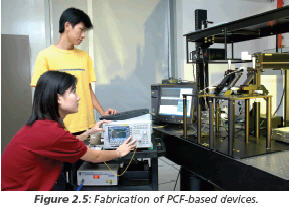
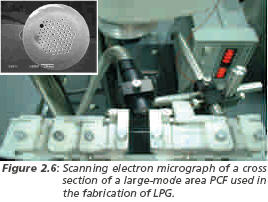
Nonlinear fibre optics
When you dial a number on your phone or
press the “send” button for your email, you actually initiate
a series of light pulses on an optical fibre. The quality of
the established communication link depends on both the
strength and the shape of pulses when they reach the receiving
end. Although optical pulses of less than 100 ps can be
transmitted through several hundred kilometers without
conversion to an electronic form, the signal quality is
ultimately limited by nonlinear interactions between the
information carrier lightwaves and the transmission fibre.
NTRC’s nonlinear fibre optics group has been actively involved
in theoretical and experimental investigations on the optical
fibre telecommunication systems operating under nonlinear
regimes. Key research areas include: fibre soliton laser,
polarization mode dispersion, fibre Raman amplifier (FRA),
optical buffer, wavelength converter and photonic microwave
devices.
Traditionally, the light pulse propagating
along the optical fibre deteriorates due to the chromatic
dispersion of fibre. Therefore, dispersion compensation must
be implemented to maintain highspeed data quality. However, by
exploiting the nonlinear effects, fibre dispersion can be
overcome and resulted in a very stable optical pulse known as
soliton that is essential for the next generation optical
networks and forms the major part of our research. We have
realized a 72 fs ultrashort soliton pulse output from a
passive mode locked fibre laser at 1550 nm wavelength, which
is the shortest soliton pulse ever obtained from fibre cavity.
In addition, we are also developing the ultra-high repetition
rate fibre soliton lasers at 660GHz, as observed by passively
mode locked technology. TeraHz pulses were observed in
parametric amplifier based fibre ring laser. A multichannel 4
x 40 Gbps fibre soliton source using active mode locking
technique is in the progress of developing.
With the development of large-scale optical
transoceanic and terrestrial network, the signal attenuation
due to inherent fibre loss must be offset. Comparing with the
traditional Erbiumdoped fibre amplifier (EDFA), FRA based on
the Stimulated Raman scattering in optical fibre attracted
considerable attention due to its improved noise performance,
simplicity and broadband feature. A novel all-optical
double-pass discrete FRA has been developed in our lab with
optimized gain and noise performances. Furthermore, a highly
efficient wavelength conversion with 50 nm bandwidth based on
Raman-enhanced parametric four-wave mixing is achieved in our
doublepass configuration.
Optical buffer is a key component for
future packet-switching all-optical networks. A novel dualloop
optical buffer (DLOB) based on 3 x 3 collinear fibre coupler
has been proposed and implemented experimentally. This optical
buffer provides random read/write access and over 1
millisecond buffer time.
Polarization effects in optical fibres
plays an important role in optical fibre communication systems
and sensoring systems. We focus on the general theoretical
description of polarization effects, measurement and real-time
monitoring of polarization mode dispersion (PMD) vectors, and
the distributed measurement of birefringence,
polarization-dependent loss (PDL) and PMD by using
Polarization Optical Time Domain Reflectometry (POTDR). The
PMD & PDL emulator and PMD & PDL compensator are being
developed. Furthermore, we conducted the fibre-based photonic
microwave research by considering the polarization effects. A
novel and simple photonic microwave notch filter using a Hi-Bi
fibre is proposed to give a fixed differential group delay (DGD),
together with a DGD element to provide tunable DGD. This
configuration overcomes the problems of optical coherence
interference and chromatic dispersion.
Organic light-emitting devices and liquid
crystal devices
Transparent OLEDs fabricated based on LiF
buffered Mg:Ag.
We have developed a new technique where LiF
is applied to buffer a low work function cathode (Mg:Ag) to
achieve improvement on electron injection, lower threshold
voltage and increase in efficiency. The turn-on voltage of the
device with 0.5 nm LiF as buffered layer is as low as 2.8 V.
At injection current density of 20 mA/cm2, the current
efficiency and power efficiency of the device is 5.56 cd/A and
1.94 lm/W respectively. Comparing the traditional device with
Mg:Ag/Ag only cathode with OLEDs fabricated with LiF buffered
Mg:Ag, the turn-on voltage is 1.6 V lower, the current
efficiency improved by 75 %, and power efficiency is almost
double.
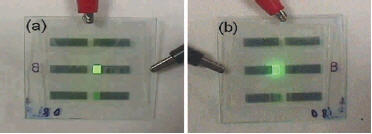
Liquid Crystal (LC) Spiral Phase Plate
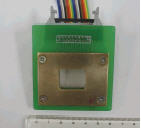 We
have fabricated a “Liquid Crystal Spiral Phase Plate” which
will generate doughnut beams for optical tweezers, rotational
frequency shift and etc. Based on the specially designed LC
cell of 18 um, where the phase plate is driven by a
multi-channel analog output card and in additional with the
development of a software to program the driving voltage, the
topological charge of the Laguerre Gaussian beam can be
changed in about one second.
We
have fabricated a “Liquid Crystal Spiral Phase Plate” which
will generate doughnut beams for optical tweezers, rotational
frequency shift and etc. Based on the specially designed LC
cell of 18 um, where the phase plate is driven by a
multi-channel analog output card and in additional with the
development of a software to program the driving voltage, the
topological charge of the Laguerre Gaussian beam can be
changed in about one second.

High Efficiency Polarization-Insensitive
Volume Diffraction Gratings
We have fabricated 2 x 2 high efficiency
polarization-insensitive volume diffraction gratings based on
LC-polymer composite. The highest diffraction efficiency
achieved was 85.7%. The rise time and the decay time measured
were 36 s and 160 s respectively at an applied electric field
of 18.2 V/m. The polarization-dependant loss was 0.03 dB
measured for s- and p-polarized light at the wavelength of
632.8 nm.
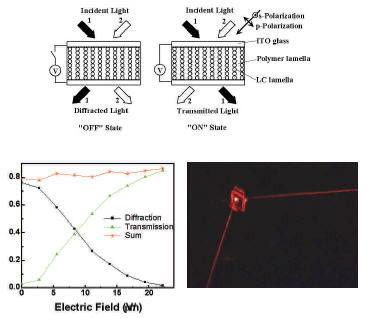
Ongoing Research Project
|
Project
Title |
Principal
Investigator |
|
UWB and Pervasive Computing Technologies
(Pilot study) |
Arokiaswami
Alphones |
|
Management and Control of Optical Networks
|
Poo Gee Swee |
|
Multi-protocol Lambda Switching for
Optical Network |
Poo Gee Swee |
|
Process and System Development for Laser
Splicing of Optical Fibers |
Rao M K |
|
Application of Polarimetric Optical Time Domain
Reflectometry
(POTDR) for Distributed Measurement in Optical Fibers |
Shum Ping |
|
Nonlinear Technologies for Next Generation
Optical Fiber Communication |
Shum Ping |
|
OptoMEMS Device Development for DWDM
System Applications |
Shum Ping
|
|
Research and Training Programme for Optics
|
Shum Ping |
|
Secured Optical Communications
|
Shum Ping |
|
Ultra-High Bit-Rate Optical Soliton
Communication |
Shum Ping |
|
Optical Signal Monitoring Systems
|
Zhong Wende |